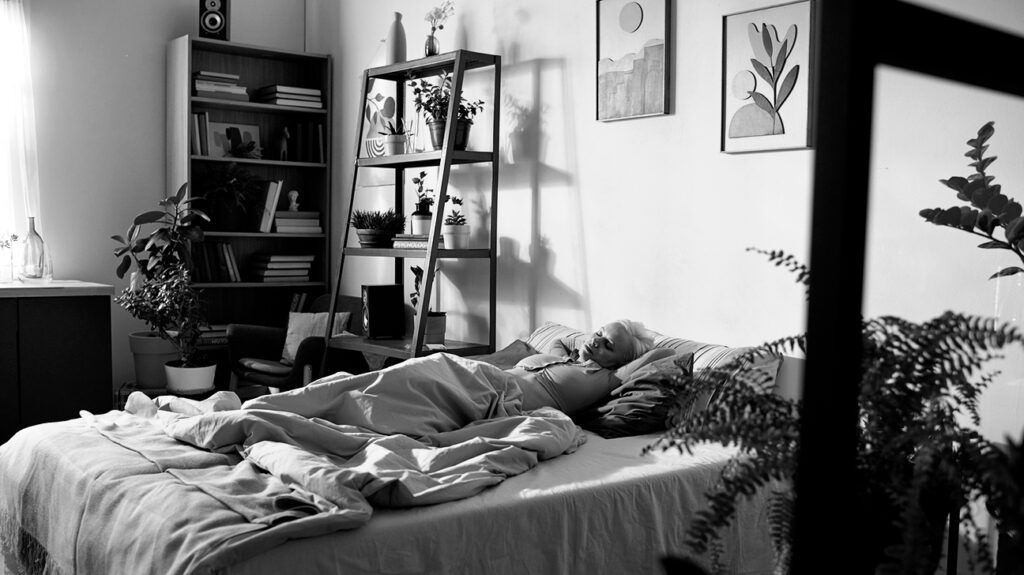Sleeping on the side of the affected joint may worsen sacroiliac joint pain (SJP). Lying on the back or using pillows to support the body, such as placing a pillow between the legs, can help to relieve SJP.
The sacroiliac joints connect the base of the spine to the pelvis. Damage to these joints or surrounding structures can cause SJP, which is typically in the lower back and buttocks and may travel down the back of the thigh to the knee.
SJP may worsen at night, particularly if a person lies on the side of the affected joint or moves suddenly in bed. Adopting certain sleeping positions and other nighttime habits may help to ease the pain.
This article explains how sleeping position affects SJP and why the condition worsens at night, offers tips for relieving nighttime SJP, and advises on when to speak with a doctor.

People with sacroiliac joint injury are
The Weill Cornell Medicine Center for Comprehensive Spine Care suggests people with SJP in one joint should avoid sleeping on the side of the affected joint.
Instead, it recommends sleeping with the affected side facing up or lying on the back.
It offers the additional following tips to help reduce nighttime SJP:
- Avoid sudden movements: Getting up or turning too quickly can compress the joint space, causing more pain.
- Use pillows as supports: Place a pillow under the knees when sleeping on the back or between the legs when sleeping on the side. This can help to relieve pressure on the joints.
- Sleep on a supportive mattress: A mattress with adequate support that is not too firm or soft may benefit people with SJP. A mattress that is too soft may not offer adequate joint support.
Sacroiliitis is the medical term for inflammation of the sacroiliac joints. A
UK-based arthritis charity Creaky Joints suggests SJP can worsen with inactivity and during certain movements, such as turning in bed. These are two key reasons the condition may worsen at night.
According to Creaky Joints, SJP that keeps a person awake at night may indicate a form of spinal arthritis known as ankylosing spondylitis (AS). Pain due to AS may:
- worsen in the morning and at night
- wake a person regularly throughout the night
- feel better with movement and worsen with rest
- last more than 3 months
Changing sleeping position may help to relieve SJP at night, but there are other steps a person can take if this is not enough to manage symptoms.
A
Transversus abdominis muscle exercise
The United Kingdom’s National Health Service (NHS) provides the following step-by-step instructions for exercising the transversus abdominis muscles:
- Lie on the back with both knees bent.
- Gently draw the lower abdominal muscles toward the spine while maintaining a relaxed breathing pattern.
- Hold the contraction for 10–30 seconds, then release.
- Repeat the exercise 10 times.
Chiropractic manipulation
A
In this type of manipulation, a chiropractor uses their hands
Kinesiology taping
Kinesiology taping involves applying a thin, stretchy tape to help with the following without restricting movement:
- stabilizing the joints
- promoting blood flow
- reducing pain
Kinesiology tape is latex-free, waterproof, and breathable. A person can wear it for up to 3 days at a time, meaning they can wear it through the night to help alleviate nighttime SJP.
A person can ask a doctor or physiotherapist for advice on applying kinesiology tape to support the sacroiliac joints.
Sacroiliitis
Some conditions that may affect the sacroiliac joints include:
- rheumatic inflammatory diseases, such as AS and gout
- degenerative joint diseases, such as osteoarthritis
- infectious diseases, such as pyogenic sacroiliitis and tuberculosis
- other diseases, such as hyperparathyroidism and lymphoma
- injury to the joints or surrounding areas
The NHS suggests contacting a doctor about joint pain if a person experiences any of the following:
- joint pain that interferes with sleep or day-to-day activities
- pain that persists following two weeks of home treatment
- constant, recurrent, or worsening pain
- joint stiffness that persists for more than 30 minutes after waking up
People should seek urgent help if they have signs of infection, including swelling or warmth around the joint or a fever.
When to seek emergency care
According to the NHS, a person with any of the following joint-related symptoms should call 911 or go to the emergency room:
- severe joint pain following a fall or injury
- tingling or numbness around the joint following an injury
- inability to bear weight on a joint
- difficulty walking
- a joint that looks or feels out of place
The sacroiliac joints connect the base of the spine to the pelvis. Sacroiliac joint pain (SJP) typically presents in the lower back and buttocks. Some people may experience pain that travels down the back of the thigh to the knee and foot.
Sleeping on the back with a pillow beneath the legs can help to relieve SJP. For side sleepers with SJP affecting one side, sleeping on the unaffected side with a pillow between the legs is another option that can help support spine and hip alignment.
Other treatment options include transversus abdominis muscle exercises, chiropractic manipulation, and kinesiology taping. Anyone with symptoms of SJP should see their doctor for additional treatment and a proper diagnosis.
